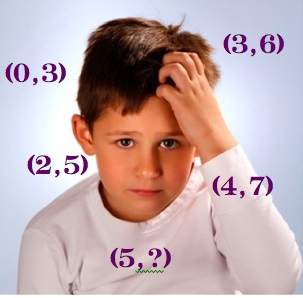You can lead a student to a pattern, but can you make them see it?
Posted by: Gary Ernest Davis on: November 22, 2010
November 11, 2010, @druinok tweeted about a High School student not able to see or express a simple linear pattern:
- @druinok how do you help a kid that doesn’t see the pattern in input/output tables?
What follows is a clutch of responses, not necessarily in chronological order:
- @druinok given the table of (0, 3), (2, 5), (3, 6) and (4, 7) cannot see that you just add 3 to the x value to find the y value
- @druinok he was given (0, 3) (2, 5) (3, 6) and (4, 7) as the ordered pairs and needed to write the function
- @republicofmath I would think ask them to tell you what they do see… @druinok how do you help a kid that doesn’t see the pattern in input/output tables?
- @republicofmath Oh, I was wondering about that. Could he make up pairs of his own that followed his own pattern? @druinok He doesn’t see anything in it :(
- @daveinstpaul @druinok Can you give him a simpler pattern, such as (1,0), (2,1), (3,2), (4,3), … ?
- @peterflom@druinok If he is visual, he might get a graph more easily. Or two parallel number lines with lines between.
- @ peterflom @druinok Or, if he learns tactilely, piles of objects (pennies, maybe? Or pebbles).
This is a basic issue in teaching mathematics.
x
Teachers want students to see patterns, to express pattens in general terms, and perhaps (though not as often as I would like) explain why a pattern holds good.
x
In one sense, a mathematics teacher’s aim is to stimulate awareness of patterns in the neuronal structure of students. Note that I wrote “stimulate awareness of patterns”. A mathematics teacher wants a student to see a pattern and to be able to use it, think about, it and reason about it and with it.
x
@druinok’s concern is that her student cannot see the pattern she sees, at least not sufficiently to articulate awareness of it.
x
She, the teacher, knows and sees that the y value is just 3 more than the x value.
x
That may be because she made up the example, or because she saw it somewhere else and recognized the pattern herself.
x
Let’s suppose it was the former: that@druinok made up this example herself.
x
In this case @druinok, like most of us teaching mathematics, is asking a student to mind read. We want the student to explore enough, to use some mental activity and agility, to recognize and be able to say that the y values are all 3 more than the corresponding x values.
x
Clearly, as @druinok reports, for some students this is a difficult task.
x
@daveinstapul, @peterflom and I suggested different ways of assisting the student to “see” the pattern. I put “seeing” in quotes because seeing is not simply a matter of visually processing something in one’s visual field: it is an intelligent activity that makes use of much more of the brain than the eyes.
x
The late Robert B. Davis, an outstanding mathematics educator, was fond of playing a game with students to address this issue of seeing patterns. The name of the game is “Guess My Pattern“.
x
In this game the teacher, or another student, would make up a secret number pattern and, given an input number from another student, would announce the output number that resulted from the pattern.
x
Bob Davis was very student centered. He would take on board student ideas without criticism or judgment, and he got them talking to each other even to the point of sharing “secret” knowledge. His methods generally lead to significant improvement in the ability of a class, or group of students, to see, articulate, and use patterns like the one @druinok gave to her student.
x
Yet class success does not imply success for every student, so the question still remains what to do with the student who, despite attempts, still cannot see or express the pattern that the teacher knows is there.
x
I would ask the student to make some number patterns of their own. How about “adding 1 to the input number”?
x
If the student cannot do that, the teacher knows they do not understand “input number” or do not know what it means, in general terms, to add 1 to a number.In other words, they might know how to add 1 to 3, or 1 to 5, but might not, yet, comprehend the idea of adding 1 to an as yet unnamed number.
x
Can the student complete a table such as the following?
| NUMBER | ADD 1 TO THE NUMBER TO THE LEFT |
| 1 | |
| 2 | |
| 3 | |
| 7 | |
| 5 | |
| 8 |
x
If the student could do that then I would play “Guess My Rule” one on one – either with the teacher or with another student.
x
Seeing patterns and being able to express them, reason about them, and use them, is basic in learning mathematics.
x
Some students take a long time to see patterns.
x
Sometimes basic assessment and diagnosis of the difficulties of a student who cannot see a pattern is necessary to get their brains thinking in a more pattern recognition mode.
x
In my experience patience and a positive attitude that success is round the corner are essential to achieving that success.
x
It’s a great moment when a student sees a pattern for themselves: it feels to them like a real discovery, and that thrill is what, in part, makes mathematics such a never-ending intellectual adventure.


Leave a Reply